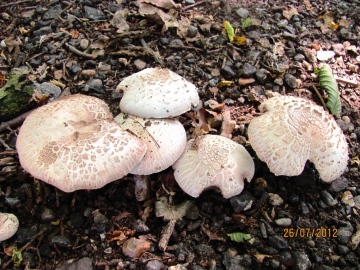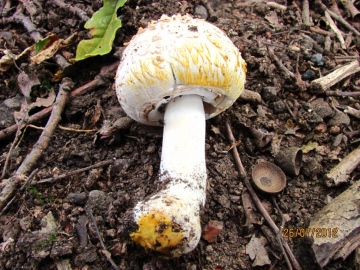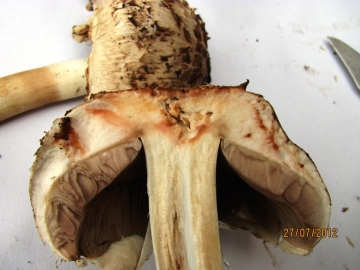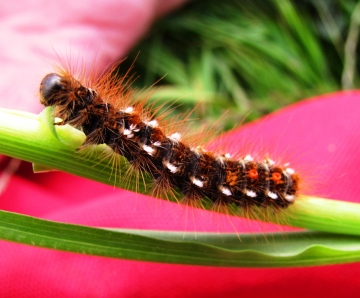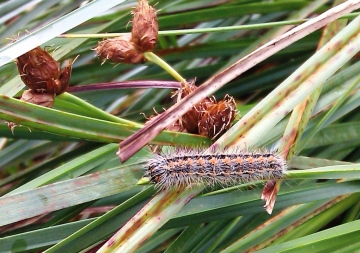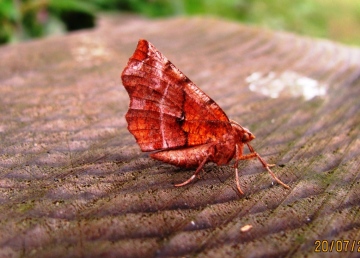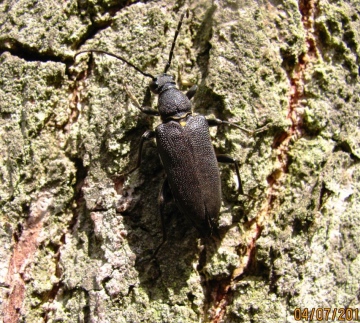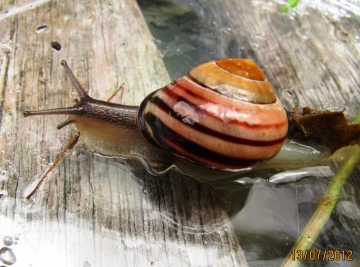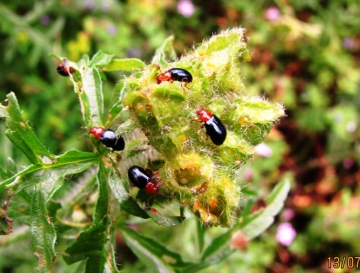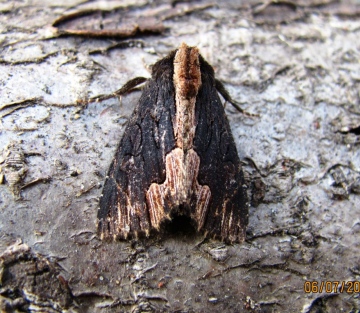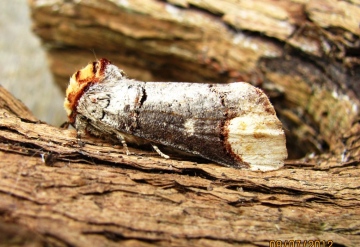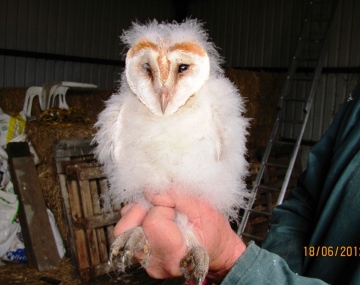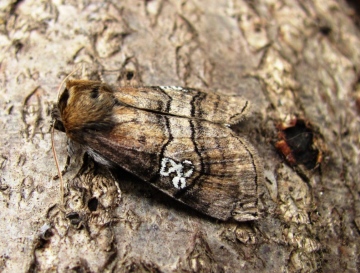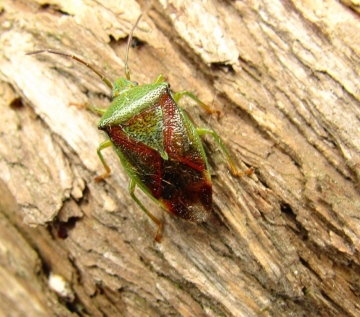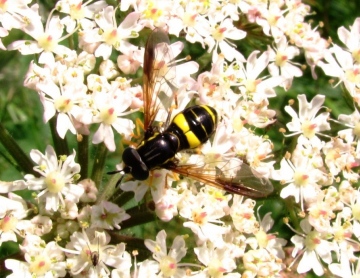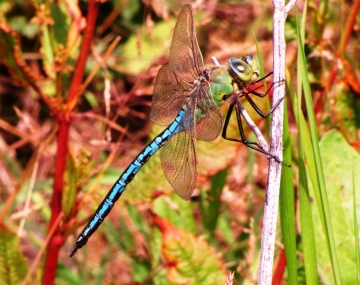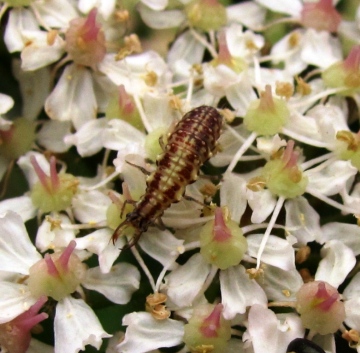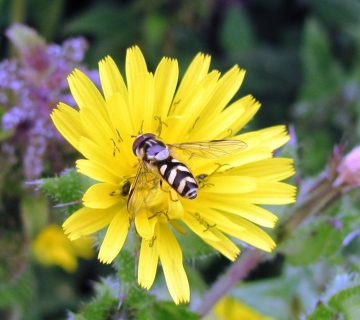Your Forum
The weblog below is for naturalists to use to report interesting sightings, ask questions, report on field meetings and generally post pictures and any information or questions generally relevant in some way to the wildlife and geology of Essex. You will need to register and be logged-on to post to the forum, and you need to upload pictures first, for use in posts. Find out more
|
Tue 31st July 2012 22:25 by Mary Smith Birds in the chimney
Thank you both for your interesting, and very different accounts of similar experiences. Maybe this is not such a rare event as I had thought. Graham's comments about loose feathers on pigeons and doves is very interesting, but I think he is extremely lucky to have seen other birds stealing feathers from the flying pigeon for lining a nest!!!
At least we did not get problems with soot, as our chimneys have not had a live fire for about 45 years. Mon 30th July 2012 08:39 by Peter Pearson Bad memories of Starlings down chimneys
In the 1960,s my wife and I were living in accomodation supplied by my then employer. Any decoration done to the property had its cost reimbursed after inspection by the employers agent. We had just finished decoration of one of the downstair reception rooms and were awaiting inspection, when lying asleep just before it was due, early morning, we awoke to hear a 'bong' ,'bong' sound. Realising it had come from downstairs we dashed down to find that a young starling had fallen down the chimney and the sound we had heard was its frantic attempts to get out of the closed window. There were sooty wing prints everywhere and the pile of soot in the hearth, trailed across the floor. I leave you to image the panic there was to clear the mess. Sun 29th July 2012 11:58 by Graham Smith A Wood Pigeon
Mary - I have never had a Wood Pigeon come down the chimney but did receive a visit from a Jackdaw and a Starling on separate occasions. Unlike you, I forgot to open the windows before removing the fireplace cover and trying to catch them. The Starling escaped and proceeded to dash around the room, landing on the curtain rail, the chair tops and the cupboards, scattering soot everywhere! The pigeon may have spread its wings in a defence posture; sometimes also they raise them as a sign of aggression. All pigeons and doves have very loose body feathers, something the local sparrows appear to well aware of. On three occasions in the past few years I have seen a sparrow in hot pursuit of a Collared Dove, eventually coming up below it and snatching a beak-ful of feathers from its belly! It presumably wanted them to line its nest with. Sat 28th July 2012 19:20 by Mary Smith A Wood Pigeon
I have just had a very strange experience with a Wood Pigeon. Our house is an old one, with 4 chimneys still with 4 pots on top on the roof. Every now and then, usually in a storm, we hear a fall of sand or similar down the one that goes to our bedroom, and this is the only one that can still be opened at the bottom. The other 3 are all bricked up. We thought they were all covered with wire mesh, but today's experience shows very clearly that at least one is not. As I went into the bedroom, I heard a fluttering, as of a bird behind the cover that closes the hole. So I pulled one corner gently ajar, and there was a Wood Pigeon, very much alive and anxious to get out. I am very familiar with chickens, and I thought that getting hold of a Pigeon would not be that different from my daughter's Bantams. But the Bantams are fairly tame, and this Pigeon was certainly not. I grabbed one wing, and then the other, but he/she would not let them lie flat but stretched them fully out into the space that was now exposed, namely our bedroom. I had taken the precaution of opening the casement windows wide before trying to catch the bird, and this Pigeon had immediately seen an opportunity and took it quickly. So, while losing a feather or five, it went straight outside.
Then I looked at the accumulated heap of sand etc in the old grate. It included a very long dead Pigeon, no meat or flesh of any kind, but a sort of dessicated bird. This one had clearly fallen in but many years ago. And we never knew it was there. Our next step is to call the roof man to cover the chimney pots in order to avoid a repeat. Although I am no friend of Wood Pigeons, I would not want to kill them by starving to death in my chimney.
Has anyone else had this happen before in their home? Fri 27th July 2012 23:21 by Peter Harvey
This is an adult female Philodromus in the aureolus group, probably Philodromus cespitum, a variable species. Spiders cannot be identified to species in this group without microscopical examination of adult genitalia. Fri 27th July 2012 20:46 by Peter Pearson Unidentified spider The above photographs were taken in trees bordering the car park at Tesco's, Highwoods, Colchester. The spider was obviously guarding her nest and was quite defensive, making no attempt to leave her eggs to this intruder. I have not noted this spider before and would be interested to know what it is. Fri 27th July 2012 15:30 by Graham Smith Agaricus xanthodermus? Mary, over tou you
Mary,
What do you make of these three photographs? They were taken at Stow Maries Aerodrome yesterday. Have you ever seen Agaricus xanthodermus with this kind of scaly cap? Perhaps the result of heat stress? The cap edge and stem base turn bright yellow to the touch, suggesting xanthodermus, but the cut flesh turns reddish-brown in the cap, which is unlike that species. Yellow-staining Agaricus are a small group and you would think it might be easy - or perhaps I should know better by now! The only other possibility would appear to be the rare A. phaeolepidotus. Flora Neerlandica (5) states that this species does not discolor yellow on the cap edge, the yellowing in the stem base is often faint, and and that the flesh turns brownish in patches, occasionally pinkish, but not red. Funga Nordica, on the other hand, states that the flesh turns yellow on rubbing, especially on the cap margin and base of the stem, and that the flesh turns reddish after a while. Experts. Pah! I do not have Geoffrey Kibby's Book - do you? That might throw some definitive light on the matter. The three people I asked described the smell as ranging between carbolic and poo - fortunately I can smell neither! The photos on the websites I've consulted suggest this species is a possibility but then, on the other hand, one states that you will be confined to the toilet for 24 hours after eating them and another suggest that they are mild tastingand delicious! I think they are a bit confused too! I've dried the specimens and taken a detailed description but I'm sure they will turn out to be Yellow Stainers but you might be able to help me there. Cheers, Graham Wed 25th July 2012 17:18 by Graham Smith July 8th to 14th 2012
Another week of varied weather; chilly and wet on 8th-9th, showery on 10th; sunnier and warmer on 11th, wet on 12th, sunny and warm on 13th and wet again on 14th! On Tuesday the Blue House volunteers carried out the annual Water Vole survey on the reserve. It was not easy this year as whereas, normally, we are able to walk along the water's edge on the fleets looking for latrines, this summer the water's edge was often half way across the adjoining field! One of the problems the reserve has is Azolla, the Water Fern, a native of South America. During the summer months some years it chokes several of the ditches, forming a dense mat on the surface which, in autumn, dies back to leave a disgusting brown sludge. It has a reputation for appearing in an area, flourishing for a few years, then disappearing as quickly as it came. Unfortunately, that has not been the case at Blue House, where it has been a problem since the EWT purchased the reserve twelve years ago. Capybara may be able to swim through it but Water Voles cannot and they vacate those ditches that are infested with it. For instance, one ditch, on the Flat Fields, often produces a count of 80-100 latrines in the hundred metres surveyed each summer; last year, and again this, there were none. Despite this, there still appears to be a healthy population on the farm.
You have to keep your wits about you when wading through the reeds less you barge into a Reed or Sedge Warbler's nest and tip the eggs or young into the water - not an ideal scenario on a nature reserve! You often come across other things of interest too, though, which today include the Horse Hair Parachute Marasmius androsaceus, growing on old reed stems, and these two caterpillars, a Brown-tailed Moth (above) and Reed Dagger, below. The warm and sunny weather on Friday enabled me to carry out my weekly butterfly transect on the reserve with some hope of seeing a few! The cold, wet spring had a disastrous effect on many of the single brooded species that appear then but the summer grassland species appear to be doing well, despite the fact that a thin film water still covers large parts of the flatter fields, even this late in the summer. The one exception is the Common Blue : numbers peaked at around 500 in 2010, crashed to a maximum of 23 last year, while this summer I have not seen more than two together! However, on 13th and the week following, there were counts of 950 Meadow Brown, 300 Gatekeeper, 230 Small Heath and 44 Small Copper, the last two species reaching record levels on the reserve since regular transects began in 2007. There is plenty of grass for their caterpillars to feed on, or in the case of the Small Copper, Sheep's Sorrel, and in places I was struggling through a knee high mat of clovers, vetches, tares, vetchlings and other flowers including these, ahem, Strawberry Clover, a scarce species in Essex which seems to be found mainly along the coast. Another species which appears to be thriving in this area is the much rarer Sea Clover, which I did not photograph!.
Catches in the moth trap on the reserve also continue to improve and included a fine, late brood, Early Thorn this week. Finally, this Longhorn Beetle Stictoleptura scutellata was snapped at The Backwarden. It appeared to emerge from the log pile near the fire site and landed on an oak nearby. Apparently it is quite a rare species but has recently been spreading its wings from its Essex HQ, Epping Forest. The identification was confirmed by both PH and Peter Hammond. Tue 17th July 2012 12:08 by Mary Smith Re Graham Smith's piece of 14 July
Oh dear, oh dear, I thought Graham knew me better than to say I am a keen gardener! The truth is that I am a very reluctant gardener, thinking of the minimum I can get away with and then halving it. We grow a few fruit and veg, mainly some apple and pear trees, which get pruned about every 4th year, we grow tomatoes and new potatoes, and we have a group of raspberry canes which never get staked so they fall over when it rains and have a struggle to get up again, and they share their space with numerous tall grasses, hybrid Bluebells that arrived from next door, and the odd tree seedling. We sort of mow a 'lawn' at intervals, but not very often. That is as far as it gets. We have a number of decorative perennials, woody and herbaceous, but they have to fight it out, and I only know the names of a few of them. We have some huge 'weeds' of various kinds, some of which are given tender loving care. So, to ask me to identify a garden plant from a pic of the thing in fruit only, is a somewhat hopeless request. Sorry, Graham, no idea! Mon 16th July 2012 22:31 by Peter Harvey
Yes, this is Xanthogramma pedissequum (although there is believed to be a second and possibly even third British species hidden in the taxon). You will see from the text underneath the maps for hoverflies that the county maps for this group are not based on full county data, so they do not give an accurate picture of the whole recorded distribution. It is a widespread hoverfly, but not usually seen in large numbers. Mon 16th July 2012 20:18 by Peter Pearson 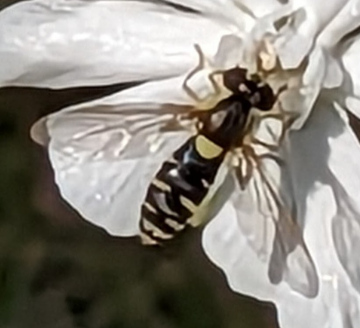 This hoverfly was photographed during one of our rare sunny moments at Highwoods Tescos. I believe it to be Xanthogramma pedissequum, but would welcome comments. If it is this hoverfly it does not appear to be too common on the Essex species account. Incidentally it appeared with a Large Skipper and a Comma. Butterflies seem to have taken a real hammering this year, very few being noted in the North East. Sat 14th July 2012 11:27 by Graham Smith July 1st to 7th 2012
I feel like an inhabitant of Lilliput washed ashore in the land of the Brobdingnagians. The endless rain has generated a lot more foliage in the garden than it has flowers and when I sit supping a cuppa on the seat near the pond greenery towers above my head. Two of the Ragwort, which I cultivate for the benefit of Cinnabar and Ruby Tiger caterpillars, have attained a height of 6' 2", and the Musk Mallows 5' or more. Mark Hanson has measured a Fool's Parsley in his garden at Boreham at 5' 3" and I recently walked through a forest of Hemlock along the River Wid that were over 12' high! The rain has also benefited slugs and snails - to the detriment of virtually everything I would like to eat myself apart from Parsnips and Loganberries - the latter too tart for their taste buds perhaps! They have even shredded the potato tops, but not the ones with Black Spot! I recently pulled up a couple of rows of Mange Tout - about half the crop of which had been eaten by them during the preceding few weeks - and counted 37 Garden Slugs Arion distinctus, 29 Large Red Slugs A. rufus, 12 Brown Garden Snails Helix aspersa, 9 Brown-lipped Snails Cepaea nemoralis (pictured) and 7 White-lipped Snails C. hortensis adhering to the stems and leaves. They now reside at Fryerning Churchyard.
Another species that is very common in the garden at the moment is this tiny beetle, which seems to feed in the flower-heads of a wide variety of species. I am sure it is up to no good but have no idea as to what it is. I'm sure a keen gardener like Mary will know though! Have visited two gardens this week that are far posher than mine. The first of these - a pad belonging to someone I have a lot of time for - was Highgrove. This was truly my sort of garden; one that is soft round the edges with not a ruddy Dahlia or Pot Marigold in sight! I had expected to be shown round by someone in a green teashirt and wellies but the chap was more like the the butler! I particularly liked the artifacts made from redundant ecclesiastical stonework following restoration repairs - virtually every cathedral in the land seems to be represented there - and also the so-called Stumpery, although it was rumoured that Prince Philip inquired when the bonfire was taking place when he first saw it! After several years' maturity the wild flower meadow now looks completely natural and both Common Spotted and Southern Marsh Orchids have colonized it of their own accord. It is wonderful what you can do when you've got thirteen gardeners at your disposal but the ideas are all his of course. Both Dahlias and Pot Marigolds abounded in the second garden - Hampton Court. This is even posher.No houses in the surrounding area for under a million I would have thought. Henry V111 wouldn't be allowed to live there nowadays - he would lower the tone of the place. Still, it was a beautiful palace and there were plenty of other flower beds with insect friendly plants. Alas, there were very few insects to benefit from them, something I have noticed in many other places throughout this summer. Bees were in particularly short supply and I only saw a single butterfly all day even though, unlike Highgrove, it was not raining. The most colourful insects were several Banded Demoiselles which had wandered from the River Thames nearby. The lack of aerial insects this summer probably explains why the young Swallows in the porch of the New Hide at Blue House died in the nest while still only half grown. On a previous visit the adults were feeding them but only at long intervals - despite the youngsters constant calls - and the likelihood is that they starved to death, a fate which, according to the BTO has befallen the young of many species this year. On a more cheerful note, the milder nights of late has seen a marked increase in captures in my garden moth trap including these two striking species, a Bird's Wing and Buff Tip. The latter is perfectly designed to imitate the broken tip of a small birch branch and that is where it resides throughout the daylight hours, relying on this camouflage to protect it from the hungry eyes of birds. Sat 7th July 2012 11:34 by Graham Smith As I was saying..............
As I was saying, there is no shame in making an honest mistake or two and PH has just pointed out to me that the picture of what I thought was a Juniper Shieldbug is in fact a Birch Shield Bug. The two are quite different, so I'm not sure where I went wrong there. The Juniper Shieldbug is much larger (ahem, actually smaller - I misquoted the fact sheet mentioned below, as PH has pointed out to me) and has distinctive pinkish-red curved markings on the corium. He has also pointed out that the dianostic feature used to separate these two species in the keys is that the first antennal segment in Elasmostethus (Cyphostethus) tristriatus(Juniper SB) does not reach the apex of the clypeus (front of the head), whereas in Elasmostethus interstinctus (Birch SB) it reaches beyond.
It may have had something to do with wanting to finish my piece for this forum before going to watch something on the box - or may be I simply misinterpreted the key on the Natural History Museum guide to Shield and Leather Bugs, which is the one I rely on for these insects. Probably the former! In either case it was an act of sloppiness - probably as the result of a mind that all too often feels it needs to be somewhere other than where it is at present - and I have amended the caption on my previous piece accordingly! Tue 3rd July 2012 20:50 by Peter Pearson Never too old
Graham, One thing I have learned in my three score and ten+ is that you are never too old to learn and that one learns by ones mistakes. A few years back the late Bill Tucker ran an article in the local paper asking for Volunteers to help record Ladybirds for the London an Essex Ladybird Survey in which I became involved. This opened up a new world for me, as like you I am a birwatcher (not a birder or twitcher) and although had had a general interest in all things to do with natural history, now realise there is so much I did not see. Even our 'pocket handkerchief' sized garden and puddle that stands in for a pond, daily reveal something new. Only the other day while tending plants I noted the below moth on a trellis 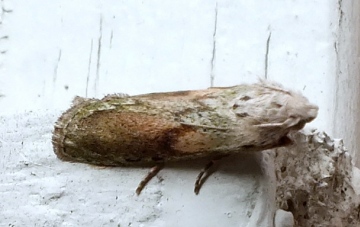 I had never seen it before, researched it and found a account and picture of it in my old Oxford Book of Insects, the more modern ones did not include it. The web then confirmed the ident and although regarded as common in most of the country appearded to be missing from much of Essex, why? Walks like one this evening turn into searches for anything to be found. It was noted that Woodlice were out along a wooden fence where they appeared to be tucking into lichen. I had never seen this before, so now I want to know do they feed on lichen. Each day leads to more questions. Mon 2nd July 2012 16:14 by Graham Smith June 10th - 30th 2012
Spring has now shivered and drizzled its way into summer and shows little sign of improving. At the beginning of the period under review it began raining on the afternoon of 10th and it continued unabated throughout the next day, not stopping until the morning of 12th, after which it remained cold and damp for a further twenty-four hours. At Blue House most of the Lapwing chicks that had hatched from late clutches succumbed to the weather, as had most of their early hatching counterparts in late April. Even at the age of around three weeks - which many of these were - their feathers are not fully waterproof and their bodily reserves of fat are very limited. Also, of course, the invertebrates on which they feed are in short supply because of the conditions; thus the chicks soon perish. The 25-27 pairs breeding this year probably fledged no more than 6-10 young, way below the 0.7 per pair that is thought necessary to maintain a population. A shame, as the breeding season was shaping up well in the early part of the spring. A natural event of course but in the modern landscape - where Lapwings are largely confined to a few wetland reserves like BH - even one poor year can have a serious impact.
Not all the news from Blue House is bad. Small birds such as Meadow Pipits, Skylarks and Reed Buntings have produced a great many young, their cause aided, perhaps, by the extraordinarily lush grass this spring, which has better shielded their nests from sharp eyed aerial predators such as harriers and crows. In addition, no less than three pairs of Barn owls are breeding in boxes on the reserve, all of which currently have young, including this one, which was one of three fledged from the box in the barn at the farm. There is obviously a thriving population of small mammals on the reserve, a tribute to Nick Robson and Tim Lawrence, who run the place, as when the EWT took over the farm twelve years ago all the fields had been grazed down to the knuckle by an overdose of sheep! Butterflies have fared as badly as many birds. Compare these two sets of figures. Those in brackets denote the numbers seen during my weekly transect of the reserve on June 29th this year; those outside are those recorded on the same date in 2011. Meadow Brown 1040 (86), Small/Essex Skipper 439 (0), Small Heath 154 (22), Small White 78 (0), Large Skipper 73 (2), Green-veined White 62 (0) and Common Blue 22 (0). Rob Smith, the Butterfly Recorder, reckons that most species are three weeks behind schedule this year so numbers may pick up if the weather improves during July. One group of organisms that have benefited from the wet weather (apart from the slugs) are plants, the hayfields on the reserve bursting with leguminous colour, notably, thousands of Grass Vetchling and swathes of Common Vetch, Smooth and Hairy Tares, so thick on the ground that they trip you up. There are also fine displays of Knotted Clover and Knotted Bur Parsley on one of the counter walls. The shot below was taken in 2010 and is of Corn Chamomile in Nick's garden. He planted part of it with a wildflower mix a few years ago and this is the result. I never expected to see such a spectacle in the wild in Essex but a few years ago an old pond on the edge of farmland at Fryerning was drained and ploughed, preparatory to it being incorporated into someone's garden. The following spring it was completely covered in Corn Chamomile - perhaps 1500 to 2000 plants in total - so perhaps fallow fields in the past really did look like this! Summer appeared only briefly during this three week period, both 27th and 28th being hot and steamy. The moth trap in the garden suddenly came to life and produced catches well into double-figures for the the first time in many weeks, this Figure of Eighty being among the species caught. Another catch was this Birch Shield Bug, the third species I have trapped this year, the others being the Green and Hawthorn. The 28th was spent wandering round Stow Maries aerodrome trying not to expire from the heat - but I stubbornly refused to moan about it! Even here on such a day the Hogweed test confirmed that it is a very poor summer for most insects. During a good one the flat white umbels play host to a multitude of nectar or pollen seeking bugs and flies but I struggled to find any insects to photograph this time. One that did oblige me was the distinctive hoverfly Chrysotoxum bisinctum, below. The Field Club database shows this to be fairly common and widespread in the county, particularly the south, but there are no records along the Crouch. However, the map may more clearly depict the distribution of hoverfly recorders rather than the hoverfly itself! Another species that stayed still long enough for me to get a snap was this fine male Emperor Dragonfly. A good day - one to recharge the batteries in preparation of the rain to come! Finally, another mystery insect, which I think may be a Lacewing larva. Considering that the adults are gentle, flimsy winged things it looks a bit fierce if it is! Sun 1st July 2012 12:27 by Graham Smith You Stupid Bird! Insect ID.
Michael - it's a funny coincidence but a book entitled 'Bird Sense. What it's like to be a Bird' has just been published by Bloomsbury Press. It is written by Tim Birkhead and has just been reviewed (favourably) in British Wildlife magazine. I have not had a chance to read it yet but hope to do so shortly. If intelligence is related solely to problem solving then perhaps some birds are better evolved to do this than others. Many years ago, in the era of silver topped milk bottles and regular milk deliveries, a Blue Tit or two discovered that if they peeled back the silver tops on milk bottles left on back door steps they could access the cream beneath. There was no skimmed milk in those days! Within a remarkably short space of time Blue Tits throughout the land were doing this, having presumably learned the trick from others, perhaps simply by watching them. Is that instinct? In Japan, where many town streets are lined with trees, including Walnuts, crows have been filmed placing the said nuts in front of cars while they are stationary at traffic lights. When the cars move off they crack the nuts and when the lights turn red again the crows nip down and get their reward! Now that is problem solving surely?
Peter - in the same magazine Peter Wright, who writes a section on beetles, raises the point that the advent of the digital camera has led to a plethora of websites devoted to insect ID, not all of which are reliable. Many show pictures which are incorrectly identified or on which key features for specific determination are not visible. This may have been the case with your attempts to identify the hoverfly. One he recommends for beetles - and which I used to tentatively identify my recent photo of a Tan Bark Longhorn - is run by the Watford Coleoptera Group (http://thewcg.org.uk/) and another, for longhorns (www.cerambyx.uochb.cz/) he rates as excellent. The upside of digital photography is that it has helped generate a burgeoning interest in previously 'unfashionable' groups of insect but as Peter Wright states the various websites devoted to them need to stress the limitations of correct insect ID from photographs. That way they can both encourage and direct the interest of potential new recruits. The important thing, in my view, is no one should every be afraid of making honest mistakes. You learn as you go along. Among my many sins is that I am a birdwatcher (or rather a 'Birder', which is the masculine version of the same thing and the one they insist on using nowadays). Birdwatching encompasses many levels of interest whereas 'Birders' are more typically concerned with rare or unusual species. At its extreme it can be extraordinarily competitive and sometimes quite nasty. Many see their lists in terms of personal achievement - the bigger the list the bigger the achievement - and some seem to derive more pleasure from rubbishing other peoples' records than correctly identifying their own! Among the other natural history disciplines I am interested in are botany and mycology. With these, even collected specimens can be misidentified or, more often, frequently re-interpreted in the light of modern day knowledge. The County Recorder for fungi sent a specimen of a scarce Waxcap to Kew, where it was confirmed by one of the experts there. More recently, in the light of DNA analysis, it has been re-identified as a colour form of a much commoner species. That is no reflection on the skills of the expert concerned. This is happening all the time with fungi at Kew; species that were originally identified using the macro and micro characteristics thought correct at the time have subsequently been proved to be something else. When you are interested in fungi you almost expect this to happen nowadays but it does not stop you trying to identify them, using the best knowledge available to you at the time. As for hoverflies, the book PH mentions is excellent but expensive; you could try contacting the British Hoverfly Society and see if they recommend any websites for hoverfly ID. Some are relatively easy to ID from photos but others, such as the Cheilosia, are a no no. Even in the former instance I would not seek to add them to the county database without running them past the County Recorder for hoverflies first. As for bees, I would not dare!!! That being said I will put my ID skills where my mouth is and offer you a photo of Dasysyrphus albostriatus (I hope), taken last summer at Stow Maries Aerodrome. |
Archives: May 2020Aug 2019 Jan 2019 Sep 2018 Jul 2016 Oct 2015 Jul 2015 May 2015 Apr 2015 Mar 2015 Feb 2015 Jan 2015 Dec 2014 Oct 2014 Sep 2014 Aug 2014 Jul 2014 May 2014 Apr 2014 Mar 2014 Feb 2014 Jan 2014 Dec 2013 Nov 2013 Sep 2013 Aug 2013 Jul 2013 Jun 2013 May 2013 Apr 2013 Mar 2013 Feb 2013 Jan 2013 Dec 2012 Nov 2012 Oct 2012 Sep 2012 Aug 2012 Jul 2012 Jun 2012 May 2012 Apr 2012 Mar 2012 Feb 2012 Jan 2012 Dec 2011 Nov 2011 Oct 2011 Sep 2011 Aug 2011 Jul 2011 Jun 2011 May 2011 Apr 2011 Mar 2011 Feb 2011 Jan 2011 Dec 2010 Nov 2010 Oct 2010 Sep 2010 Aug 2010 Jul 2010 Jun 2010 May 2010 Apr 2010 Mar 2010 Feb 2010 Nov 2009 Oct 2009 Aug 2009 Jul 2009 Jun 2009 May 2009 Apr 2009 Mar 2009 Feb 2009 Jan 2009 Nov 2008 Oct 2008 Sep 2008 Aug 2008 Jul 2008 Jun 2008 May 2008 Apr 2008 Mar 2008 Feb 2008 Jan 2008 Dec 2007 Nov 2007 current posts |
























